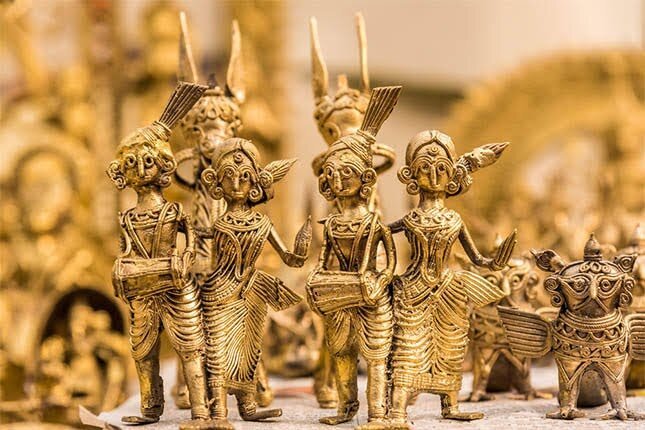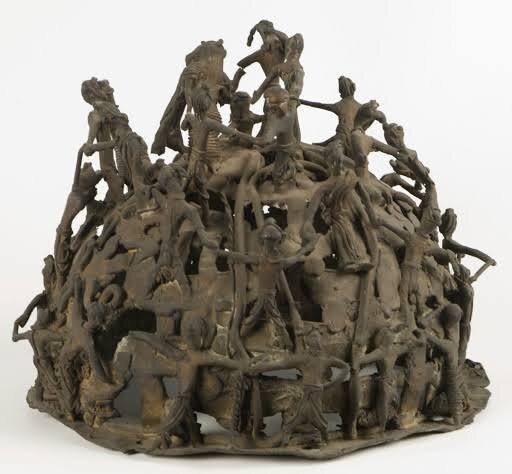Exploring Indian Art Beyond Paintings - Dhokra Brass Work
When we talk or think about art, the first and most of the time, the singular thing that comes to our mind is painting. The collective perception of equating art with painting has been a norm for centuries. But the world of art was never limited to painting alone. There are innumerable other forms of art that deserve the same kind of attention that paintings get. Additionally, various interesting art forms originate from places and communities that have been kept away from mainstream narratives for the longest time. Such forms carry historical, political, and cultural relevance beyond the definitions of fine art or high art.
The Indian Art world isn’t isolated from this phenomenon either. In his book, Indian Art, Partha Mitter says, “The view of the applied arts as being inferior to the fine arts has been an implicit assumption of Indian art history grounded in the Renaissance hierarchy of the arts.” In the same chapter, he talks about “non-canonical” arts which belong to the sections of the society which are kept away from the limelight. Such a deep lag in the awareness of the common mass about the country’s artforms stem from the profound and intense play of socio-economic aspects and hegemonic cultural integration in pedagogy and mainstream discourse.
What is Dhokra Brass Work?
Dhokra is an ancient form of metal craft and can be traced back to 4000 years. The famous Dancing Girl unearthed at Mohenjodaro is a product of this kind of metalwork. In contemporary India, it is the Ojhas of West Bengal, Orissa, Jharkhand, Chhattisgarh and Telangana who practice this art form.
The Dancing Girl, Mohenjo-Daro.
The Dhokra brass work method requires extensive artistic skills and practice. The method is lengthy and it takes a lot of effort to create an artefact using the process. The lost-wax technique is used to create objects which are often small in size and appropriate to join a collector’s shelf. Figurines and sculptors produced by Dhokra artists are famous worldwide. Human and animal figures dominate this sort of art. However, over time several other themes have been explored by Dhokra artists.
Human Dhokra figurines.
The Process
It can take up to 4-5 days to create one figurine due to the elaborative nature of the Dhokra artform. At first, the artist makes a core made of clay. This core has a rough shape of what the artist finally aims to create. The clay mould is then covered with beeswax. Alternatively, wood gum or tar is also used. Once covered in wax, the precise designs and the intricate details are made. This is the most crucial as well as the most challenging part of the process. After the designs are made, the object is covered with a layer of clay to form a cast.
Covered in clay to form a mould.
Thereafter a hole is made on the mould through which molten metal or alloy, in this case, brass, is poured in. Once it's poured, the metal hardens and takes the shape of the inner core and falls into the designs on the figurine. In one of the final steps, the mould is heated on a hearth. It is during this step that the wax melts and drains out through the ducts which are made beforehand. The hole that was made to pour in the metal is closed and the object is left to cool down. After the object is completely cooled down and well-rested, the outer layer of the clay is removed and the metal structure inside is revealed.
Liquid metal/alloy being poured in.
Dhokra Art is not only mesmerizing but due to the metal used, the products made are also durable. Apart from figurines and artifacts that can be used for home decor, several other items such as door handle, serving trays, and candle holders are also available for use in daily life. The combination of aesthetics and durability makes them serviceable.
Dhokra door handles.
One of the famous practitioners of Dhokra art, whose work has contributed to increasing its visibility is Meera Mukherjee. A pioneer of modern art in India, Mukherjee travelled through rural India working on a project which documented lesser-known Indian art forms, mainly tribal. That is how she was introduced to Dhokra. Once she learnt the art, there was no looking back for her. The sculptures and figurines she made using the Dhokra process reflected her extensive experience on the ground. Her subjects were common people, fishermen, and weavers, most of the people she had met in real life.
Untitled, Meera Mukherjee
This labour-intensive art form has been passed down through generations. However, in the last couple of decades, the demand for Dhokra artefacts have considerably reduced. The fact that this form of art requires precision and time makes it more expensive than factory-produced normal metal casting pieces. Apart from that, western home decor and the influence of Western sensibilities and aesthetics have heavily influenced such forms of art. The lack of awareness in people and the fact that most people are accustomed to spending on mass-produced decor pieces at cheap rates has led to a gradual decline in the demand for such artefacts.
Dhokra art is not only a symbol of artistic brilliance but also an art form that has real potential. Initiating practice of this art requires somewhere between INR 2500-3000. The main ingredients however are - skill and practice. Purnachandra Pradhan, a farmer turned Dhokra artist from Chhattisgarh in a conversation with The Hindu says, “It needs planning and skilfulness and one should be sharp during the process. Even a minute’s delay will not yield results”. This is also to imply that it's not very difficult to launch and implement ways in which Dhokra Art can be revived.
India is the amalgamation of various cultures and it is ignorant to limit the knowledge of Indian art to that of painting. It is the 21st Century and there is no place for Western canonical imports in a land where art is so ingrained in the daily lives of people. Starting from the meenakari jewelry people wear to the decorative brass and copper utensils they use, art is an essential aspect of Indian daily life. The various forms of art which represent communities and their ways of life, construct a central part of our identity as a country. The diversity that can be found in India’s tribal art is unique. Dhokra art is just one of the many ancient forms that have been preserved through centuries by communities, most of which faced oppression in some form or the other. Conservation and encouragement of such art forms are essential for the sustainable development of Indian art and artists.






